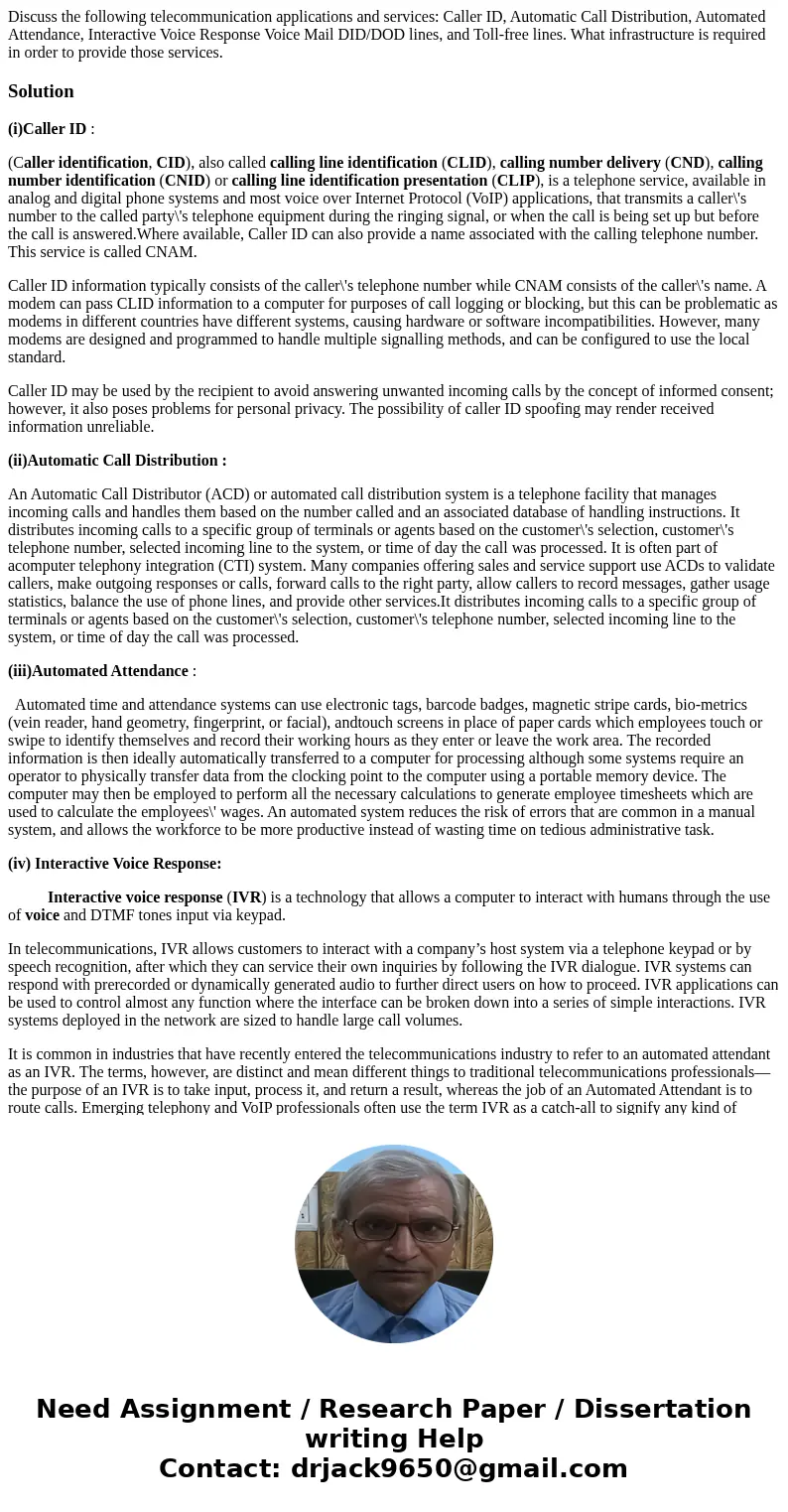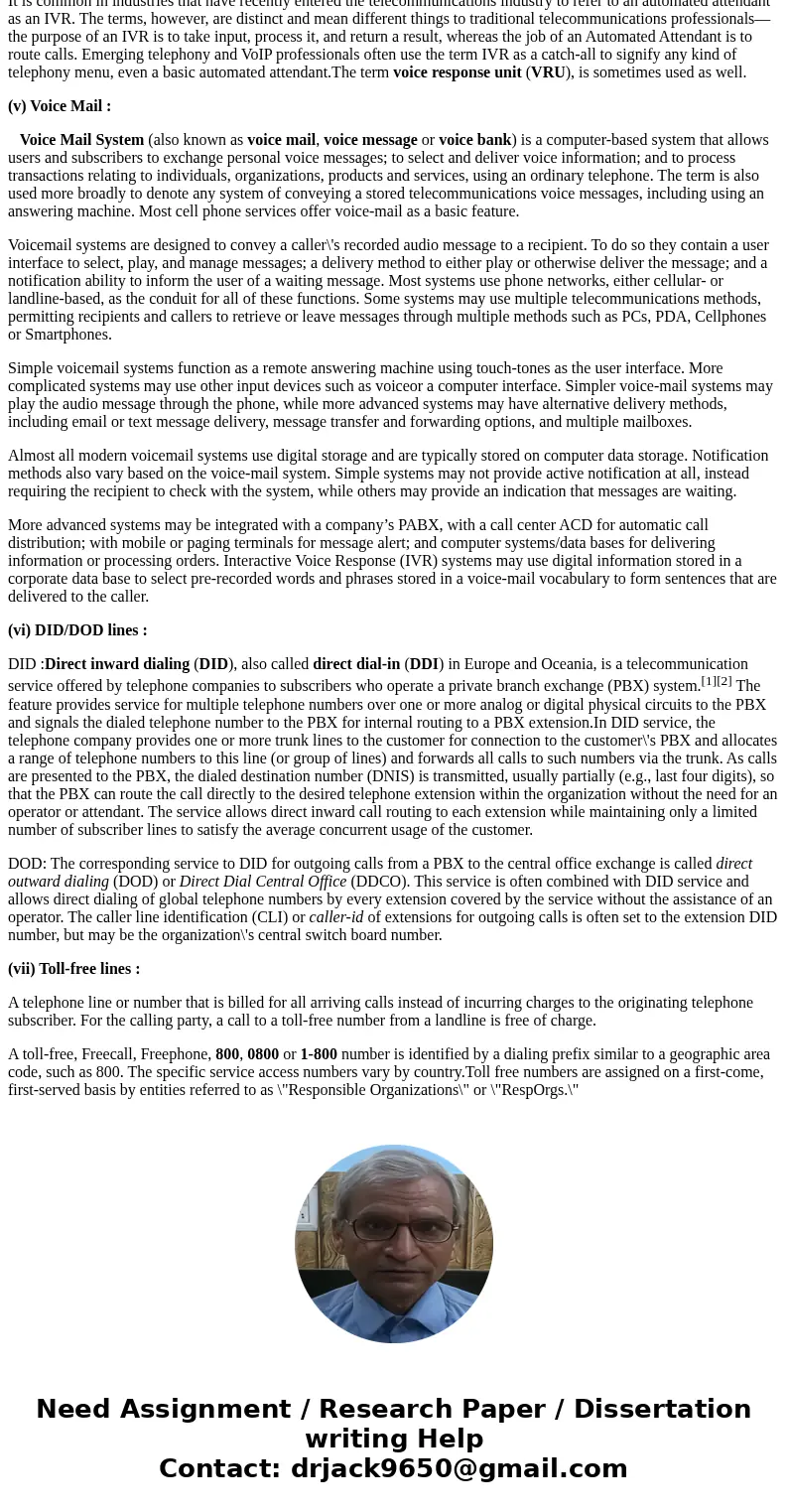Discuss the following telecommunication applications and ser
Solution
(i)Caller ID :
(Caller identification, CID), also called calling line identification (CLID), calling number delivery (CND), calling number identification (CNID) or calling line identification presentation (CLIP), is a telephone service, available in analog and digital phone systems and most voice over Internet Protocol (VoIP) applications, that transmits a caller\'s number to the called party\'s telephone equipment during the ringing signal, or when the call is being set up but before the call is answered.Where available, Caller ID can also provide a name associated with the calling telephone number. This service is called CNAM.
Caller ID information typically consists of the caller\'s telephone number while CNAM consists of the caller\'s name. A modem can pass CLID information to a computer for purposes of call logging or blocking, but this can be problematic as modems in different countries have different systems, causing hardware or software incompatibilities. However, many modems are designed and programmed to handle multiple signalling methods, and can be configured to use the local standard.
Caller ID may be used by the recipient to avoid answering unwanted incoming calls by the concept of informed consent; however, it also poses problems for personal privacy. The possibility of caller ID spoofing may render received information unreliable.
(ii)Automatic Call Distribution :
An Automatic Call Distributor (ACD) or automated call distribution system is a telephone facility that manages incoming calls and handles them based on the number called and an associated database of handling instructions. It distributes incoming calls to a specific group of terminals or agents based on the customer\'s selection, customer\'s telephone number, selected incoming line to the system, or time of day the call was processed. It is often part of acomputer telephony integration (CTI) system. Many companies offering sales and service support use ACDs to validate callers, make outgoing responses or calls, forward calls to the right party, allow callers to record messages, gather usage statistics, balance the use of phone lines, and provide other services.It distributes incoming calls to a specific group of terminals or agents based on the customer\'s selection, customer\'s telephone number, selected incoming line to the system, or time of day the call was processed.
(iii)Automated Attendance :
Automated time and attendance systems can use electronic tags, barcode badges, magnetic stripe cards, bio-metrics (vein reader, hand geometry, fingerprint, or facial), andtouch screens in place of paper cards which employees touch or swipe to identify themselves and record their working hours as they enter or leave the work area. The recorded information is then ideally automatically transferred to a computer for processing although some systems require an operator to physically transfer data from the clocking point to the computer using a portable memory device. The computer may then be employed to perform all the necessary calculations to generate employee timesheets which are used to calculate the employees\' wages. An automated system reduces the risk of errors that are common in a manual system, and allows the workforce to be more productive instead of wasting time on tedious administrative task.
(iv) Interactive Voice Response:
Interactive voice response (IVR) is a technology that allows a computer to interact with humans through the use of voice and DTMF tones input via keypad.
In telecommunications, IVR allows customers to interact with a company’s host system via a telephone keypad or by speech recognition, after which they can service their own inquiries by following the IVR dialogue. IVR systems can respond with prerecorded or dynamically generated audio to further direct users on how to proceed. IVR applications can be used to control almost any function where the interface can be broken down into a series of simple interactions. IVR systems deployed in the network are sized to handle large call volumes.
It is common in industries that have recently entered the telecommunications industry to refer to an automated attendant as an IVR. The terms, however, are distinct and mean different things to traditional telecommunications professionals—the purpose of an IVR is to take input, process it, and return a result, whereas the job of an Automated Attendant is to route calls. Emerging telephony and VoIP professionals often use the term IVR as a catch-all to signify any kind of telephony menu, even a basic automated attendant.The term voice response unit (VRU), is sometimes used as well.
(v) Voice Mail :
Voice Mail System (also known as voice mail, voice message or voice bank) is a computer-based system that allows users and subscribers to exchange personal voice messages; to select and deliver voice information; and to process transactions relating to individuals, organizations, products and services, using an ordinary telephone. The term is also used more broadly to denote any system of conveying a stored telecommunications voice messages, including using an answering machine. Most cell phone services offer voice-mail as a basic feature.
Voicemail systems are designed to convey a caller\'s recorded audio message to a recipient. To do so they contain a user interface to select, play, and manage messages; a delivery method to either play or otherwise deliver the message; and a notification ability to inform the user of a waiting message. Most systems use phone networks, either cellular- or landline-based, as the conduit for all of these functions. Some systems may use multiple telecommunications methods, permitting recipients and callers to retrieve or leave messages through multiple methods such as PCs, PDA, Cellphones or Smartphones.
Simple voicemail systems function as a remote answering machine using touch-tones as the user interface. More complicated systems may use other input devices such as voiceor a computer interface. Simpler voice-mail systems may play the audio message through the phone, while more advanced systems may have alternative delivery methods, including email or text message delivery, message transfer and forwarding options, and multiple mailboxes.
Almost all modern voicemail systems use digital storage and are typically stored on computer data storage. Notification methods also vary based on the voice-mail system. Simple systems may not provide active notification at all, instead requiring the recipient to check with the system, while others may provide an indication that messages are waiting.
More advanced systems may be integrated with a company’s PABX, with a call center ACD for automatic call distribution; with mobile or paging terminals for message alert; and computer systems/data bases for delivering information or processing orders. Interactive Voice Response (IVR) systems may use digital information stored in a corporate data base to select pre-recorded words and phrases stored in a voice-mail vocabulary to form sentences that are delivered to the caller.
(vi) DID/DOD lines :
DID :Direct inward dialing (DID), also called direct dial-in (DDI) in Europe and Oceania, is a telecommunication service offered by telephone companies to subscribers who operate a private branch exchange (PBX) system.[1][2] The feature provides service for multiple telephone numbers over one or more analog or digital physical circuits to the PBX and signals the dialed telephone number to the PBX for internal routing to a PBX extension.In DID service, the telephone company provides one or more trunk lines to the customer for connection to the customer\'s PBX and allocates a range of telephone numbers to this line (or group of lines) and forwards all calls to such numbers via the trunk. As calls are presented to the PBX, the dialed destination number (DNIS) is transmitted, usually partially (e.g., last four digits), so that the PBX can route the call directly to the desired telephone extension within the organization without the need for an operator or attendant. The service allows direct inward call routing to each extension while maintaining only a limited number of subscriber lines to satisfy the average concurrent usage of the customer.
DOD: The corresponding service to DID for outgoing calls from a PBX to the central office exchange is called direct outward dialing (DOD) or Direct Dial Central Office (DDCO). This service is often combined with DID service and allows direct dialing of global telephone numbers by every extension covered by the service without the assistance of an operator. The caller line identification (CLI) or caller-id of extensions for outgoing calls is often set to the extension DID number, but may be the organization\'s central switch board number.
(vii) Toll-free lines :
A telephone line or number that is billed for all arriving calls instead of incurring charges to the originating telephone subscriber. For the calling party, a call to a toll-free number from a landline is free of charge.
A toll-free, Freecall, Freephone, 800, 0800 or 1-800 number is identified by a dialing prefix similar to a geographic area code, such as 800. The specific service access numbers vary by country.Toll free numbers are assigned on a first-come, first-served basis by entities referred to as \"Responsible Organizations\" or \"RespOrgs.\"


 Homework Sourse
Homework Sourse